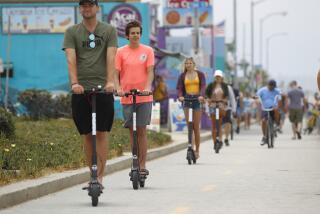Safety courses for scooter riders
- Share via
Gas prices are fueling scooter sales, but a large part of scooters’ appeal is their non-threatening profile and ease of use. You don’t swing a leg over a scooter as you would on a motorcycle. You merely step through and sit down. Nor do you need to master a manual transmission. You just twist the grip and go.
Yet scooters are prone to many of the same safety issues as motorcycles. Their size makes them difficult for drivers to see, and on smaller-displacement models in particular, their low power makes mixing with fast-moving traffic more challening.
If you want to ride a scooter and aren’t already a regular rider of two wheels, the Motorcycle Safety Foundation has a few recommendations.
First, start bicycling - “just to get used to balancing on two wheels and using the hand controls,” said Ray Ochs, MSF’s director of training systems. “Make sure you have the motor skills integrated. That’s very, very important.”
Once you’ve mastered those skills, you’d do well to sign up for a safety course. The MSF is the organization that provides most of the motorcycle-safety-course curricula to the 50 states. Two of those courses apply to scooters. Its Scooter School is a beginners’ class that teaches riders street strategies as well as how to operate the controls of scooters that are 200 cc and smaller. The four-hour class runs riders through a series of 10 exercises, but it does not conclude with a skill test; they will still have to take the riding test required by the California Department of Motor Vehicles to obtain the M1 license for operating a motor vehicle, without pedals, of 49 cc’s or bigger.Scooter School is not currently available in California, so a better option is the Basic RiderCourse administered through the California Motorcyclist Safety Program. The 15-hour course is the same safety class recommended to beginning motorcyclists. It features five hours of classroom instruction to familiarize riders with the safety issues of operating a two-wheeled, motorized vehicle on the street and 10 hours of riding that teach proper starting, stopping, braking and cornering techniques. The class concludes with a skill test that, if passed, waives the riding test at the DMV; the written test is still required for the M1 license.
Most of the sites use 250 cc motorcycles, but scooters are welcome. Beginning riders can either bring their own or borrow one from a site that already has a scooter in its regular fleet. The sites in the L.A. area that have scooters available for loan are: West L.A., the San Fernando Valley and Long Beach.
I recommend taking the class before you buy a scooter, just to make sure scootering is right for you. That way, you can find out the answer in a safe environment without having spent or risked anything but the cost of the class, which is $150 to $235.
For information on the nearest BRC and class availablility, call (877) 743-3411 or visit www.ca-msp.org.
More to Read
Sign up for Essential California
The most important California stories and recommendations in your inbox every morning.
You may occasionally receive promotional content from the Los Angeles Times.













